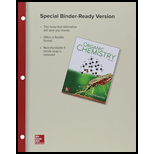
Concept explainers
(a)
Interpretation: The carbon radical which is formed by homolysis of the
Concept introduction: The formation of carbocation, carbanion and free radical occur due to the heterolysis or homolysis process. Homolysis is opposite to the heterolysis. It forms radical with an unpaired electron.
Resonance is the delocalisation of
(b)
Interpretation: The carbon radical which is formed by homolysis of the
Concept introduction: The formation of carbocation, carbanion and free radical occur due to the heterolysis or homolysis process. Homolysis is opposite to the heterolysis. It forms radical with an unpaired electron.
Resonance is the delocalisation of
(c)
Interpretation: The weaker
Concept introduction: The energy which is released or absorbed in the
Want to see the full answer?
Check out a sample textbook solution
Chapter 6 Solutions
Loose Leaf for Organic Chemistry
- All are true or false a) A radical contains an atom that has an octet of electrons. b) Chlorination is faster than bromination. c) Less stable radicals generally do not rearrange to more stable radicals.arrow_forwardWhat is the final product of this reaction? Show its mechanismarrow_forward2. In the bromination reactions, what is the function of CCl4? Why can it fulfil its role?3. Bromination proceeds by either free radical substitution or electrophillic addition. Based on Table 3, which mechanism is followed by alkanes? by alkenes? by alkynes?4. For which hydrocarbon type is light necessary for bromination to take place?5. What is the function of light in the bromination reaction? Why are alkenes and alkynes not included as samples?arrow_forward
- How does this mechanism work if OH- is a nucleophile? Would the electrons from the bond be transferred to oxygen after the nucleophile attacks the electrophile? Or is it a simultaneous process?arrow_forwardWhat reaction would acetylene likely undergo if it were kept at 1500 °C for too long?9arrow_forwardAs we will learn, many antioxidants–compounds that prevent unwanted radical oxidation reactions from occurring–are phenols, compounds that contain an OH group bonded directly to a benzene ring.a.) Explain why homolysis of the O–H bond in phenol requiresconsiderably less energy than homolysis of the O–H bond in ethanol(362 kJ/mol vs. 438 kJ/mol).b.) Why is the C–O bond in phenol shorter than the C–O bond in ethanol?arrow_forward
- A lab technician planned to synthesize 2-bromopentane using 2-pentanol, heat, and HBr. However, the labtechnician did not have HBr in the lab. What other reagent(s) can the technician use to synthesize 2-bromopentane using 2-pentanol as the starting material?arrow_forwardWhy is Ch3coo- a better nucleophile than OH-?arrow_forwardIn the reaction from compound 10 to compound 11, why the C=C bond is retained and is not hydrogenated? f) LiAlH4, Et2O, 08C; g) Ac2O, py, DMAP, CH2Cl2, RT, 77% over 2 steps;arrow_forward
 Organic Chemistry: A Guided InquiryChemistryISBN:9780618974122Author:Andrei StraumanisPublisher:Cengage Learning
Organic Chemistry: A Guided InquiryChemistryISBN:9780618974122Author:Andrei StraumanisPublisher:Cengage Learning Organic ChemistryChemistryISBN:9781305580350Author:William H. Brown, Brent L. Iverson, Eric Anslyn, Christopher S. FootePublisher:Cengage Learning
Organic ChemistryChemistryISBN:9781305580350Author:William H. Brown, Brent L. Iverson, Eric Anslyn, Christopher S. FootePublisher:Cengage Learning




